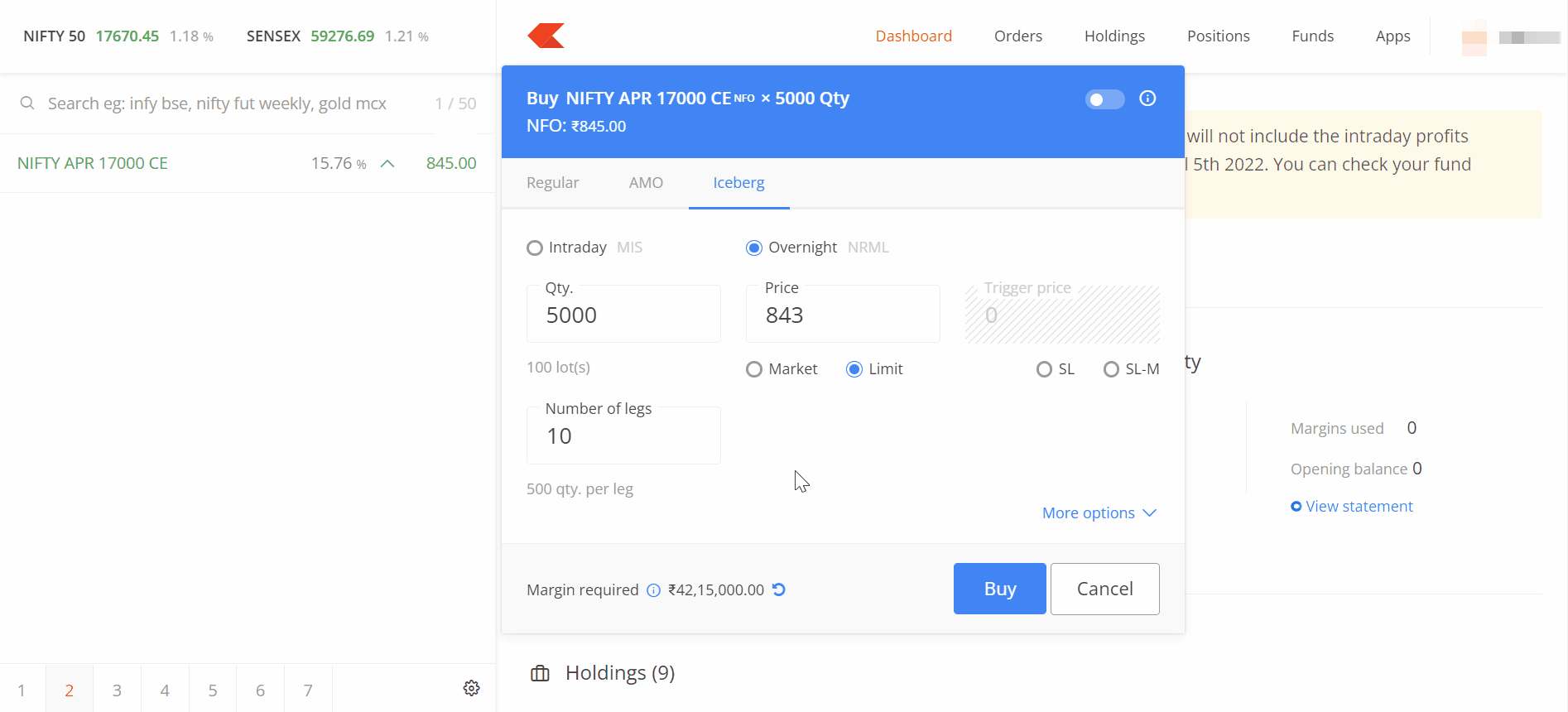What are Iceberg orders, and how to use them?
Iceberg is an order type that slices orders of larger quantity (or value) into smaller orders, where each small order, or leg, is sent to the exchange only after the previous order is filled.
Iceberg orders only allow limit orders. This helps reduce the impact cost of execution in addition to not revealing large orders in the market depth bids and offers. Icebergs are a very popular order type amongst institutional traders, and Zerodha is excited to introduce this to retail traders in India.
What is impact cost?
Impact cost represents the difference in the actual traded price compared to the instrument's price when the order was placed. For example, if a market order to buy 1000 shares was placed when the stock was trading at ₹100, and if the actual execution price was ₹100.5, this ₹0.5 x 1000 = ₹500 would be the impact cost for the order. Similarly, if a limit order to buy 1000 shares was placed at ₹100 when the stock was trading at ₹100 and later modified to 100.3 to get a fill, 0.3 x 1000 = ₹300 is technically the impact cost.
As the size of the order increases, the impact cost goes up as well. Traders with large order values end up losing a lot more money to impact costs as compared to all other charges combined (STT, Brokerage, exchange transaction, etc).
How do Icebergs work?
As the name suggests, when a large order is placed, it is divided into smaller orders or legs, and only the first leg is placed on the exchange at first, revealing only the tip of the iceberg. Once this leg is executed, the next leg of the main order is placed, and so on, until the desired quantity is traded. The number of legs is decided by the client.
Follow these steps to place an Iceberg order:
- Click on Iceberg on the order window.
- Select Intraday or Overnight .
- Enter Quantity and the Price .
- Select Limit.
- Enter the Number of legs and click on Buy or Sell . The maximum number of legs per Iceberg is 10.
Example scenario
An order for Nifty CE of 3000 quantity (60 lots) can be divided into 5 orders of 600 each by selecting the number of legs. This way, every subsequent order of 600 will be executed only once the previous orders are executed.

Did you know?
- Since each leg is a separate order, the brokerage is charged separately. For instance, if the order is split into 5 legs, then the brokerage will be applicable for 5 executed orders individually.
- If any leg of an Iceberg is cancelled, all the remaining pending legs that are yet to be placed will be automatically cancelled. Similarly, if the price of any leg of the Iceberg is modified, the new price will automatically be applied to all the pending legs.
- The minimum order value is ₹1,00,000 for equity and 5 lots for F&O.
- Iceberg orders are available for NSE equity, NFO (NSE F&O), CDS (NSE currency segment), BSE equity and BFO (BSE F&O) only. Iceberg order type is not available for MCX and BCD yet.
- Icebergs can’t be used in the case of market and SL-M orders.
-
Iceberg orders and minute validity are not supported during pre-open & post-market sessions.
-
The disclosed quantity feature can be used for equity trades which will work very similar to Icebergs, and the disclosed quantity feature doesn’t create multiple orders and hence won't have any additional costs. Disclosed quantity feature isn’t available for F&O trades. See
What is disclosed quantity feature and how to use it?
Order validity in minutes
Along with DAY (valid for the whole trading day until filled) and IOC (Immediate or Cancel) orders, Zerodha is introducing a new minute validity feature. An order can be set to auto-cancel if it does not complete in a given period of time, and this period is set in minutes. Iceberg orders can be placed with validity in minutes, along with regular orders.

Icebergs to overcome order freeze limits
Exchanges have a maximum order limit set for equity derivative contracts. The exchanges define the maximum number of contracts that can be bought or sold in a single order as freeze limits. This is an inconvenience to traders who want to execute larger quantities, requiring them to place multiple orders. With Iceberg orders, an order to buy 10000 or 200 lots of Nifty or more can be placed at the same time. This will not only mean not having to place multiple orders in case of a large order but also help reduce impact costs. Freeze quantity limits can be checked under Volume Freeze Quantity on the NSE website (WEB).
Still need help?


